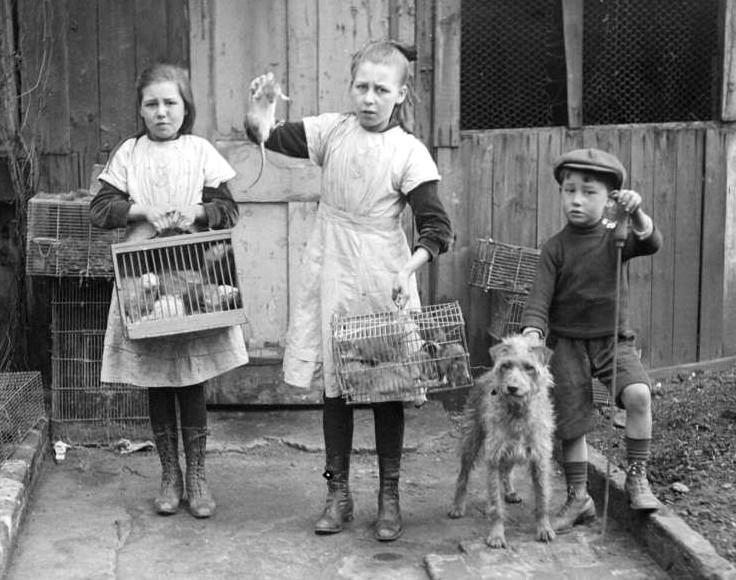😧😩😪😵🐀🐀🐀 >>>
Child Rat Catchers of the Victorian Era
By the Victorian Era it was common knowledge that rats carried diseases, and thousands of them were known to infest London sewers, factories, and homes just like they had infested France in Montfaucon in 1828. In the seasons when rats overran London, rat catchers were in high demand. Moreover, rats could be a big problem as reported by one Victorian rat catcher:
“One pair of rats … with their progeny, will produce in three years no less a number than 646,808 rats, which will consume day by day as much food as 64,680 men, leaving eight rats to starve.”[1]

Water rat and two common rats, Author’s collection.
To solve the rat problem, the demand for rat catchers can be demonstrated by William Jures. He often ran ads for rat catching positions with his want ads reading:
“Rats! Rats!! Rats!!! Wanted, engagements for exterminating the above Pests – Apply to William Jures, Professional Rat Catcher (with box traps), New steads, Cathill, late of Saddler’s Hall.[2]

“Buy a Trap, a Rat-trap, Buy My Trap” by Thomas Rowlandson. Public domain.
Many children preferred catching rats to cleaning chimneys, working in coal mines, or hawking wares. One reason rat catching was popular with the youth was because it was lucrative. De-ratting English manors and businesses earned rat catchers wages that ranged from two shillings to one pound. However, because rat catchers had to make an investment and at least own a terrier or a ferret, many rat catchers were older youths.
Rat catchers were also rat killers. To kill a rat was a straight forward task. Rat catchers often claimed to have alluring secret poisons, but in reality their prime rat-killing poison was plain old arsenic. The arsenic was mixed with “toasted cheese, or bacon, or fried liver, or tallow, or oatmeal.”[3]
A second way to kill rats involved ferrets and terriers. Ferrets would flush the rats out and trained terriers would seize them. Born a year before Eliza de Feuillide died, author Henry Mayhew wrote in his book London Labour and the London Poor, that terriers would “throttle them silently, excepting the short squeak, or half-squeak, of the rat, who, by a ‘good dog’, is seized unerringly by the part of the back where the terrier’s gripe and shake is speedy death.”[4]
Using these methods, the Newcastle Daily Chronicle reported on a rat catcher of the early 1860s named Mr. Matthew French of Hexham. He was better known as “Matt the Rover,” and, supposedly, in a single day he “with the aid of his four astute ferrets, and his ‘two game little terriers,’ [took, killed, and slayed] … the enormous number of three hundred rats.”[5]

French version of the rat catcher in the seventeenth century. Courtesy of Bibliothèque nationale de France.
If the pervasive disease-ridden varmints needed to be captured alive, there were several ways to accomplish the job. One way was to have the ferret flush out the rat and drive it into some contrivance. This was the best way to catch rats used for blood sports because it left no visible injuries, a requirement for the sport. (One popular blood sport was rat-baiting. It involved filling a pit with rats and placing bets on how long it would take a dog, usually a terrier, to kill them.)
The second reason rats were captured alive was to breed and sell as house pets. One famous rat catcher named Jack Black worked as Queen Victoria’s personal rat catcher and caught all sorts of rats, including unusual colored ones. He bred them and sold them to well-bred women who kept them in squirrel cages as pets. Jack began as a child rat catcher and in an interview in the 1800s with Mayhew he claimed:
“I should think I’ve been ratting a’most for five-and-thirty year. I’ve been bitten nearly everywhere, even where I can’t name and right through my thumbnail too … When a rat’s bite touches the bone, it make you feel faint in a minute, and it bleeds dreadful like you have ben stuck with a penknife. … The first rats I caught was when I was about nine years of age. After that I bought some ferrets, and I was, I think, the first that regularly began to hunt rats to ‘sterminate them.[6]
Jack Black. Courtesy of Wikipedia.
References:
- [1] A Rat-catcher on Rats, in Manchester Courier and Lancashire General Advertise, p. 3.
- [2] “Wanted,” in Alnwick Mercury, 24 October 1885, pg. 4.
- [3] Mayhew, Henry, London Labour and the London Poor, Vol. 1, 1851, p. 503.
- [4] Ibid.
- [5] “Rat Slaughter Extraordinary,” in Newcastle Daily Chronicle, 26 December 1861, pg. 3
- [6] BBC2 Shows what Mayhew’s London was Really Like, in Illustrated London News, 2 April 1966, p. 16.




No comments:
Post a Comment